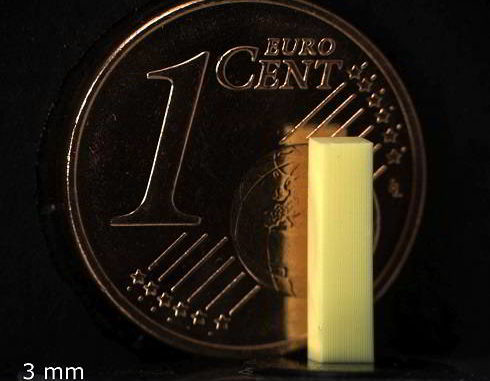
Views: 20
– KIT scientists develop new 3D printing system for submetric structures with record speed accuracy
Courtesy KIT: 3D printers that print in millimeters or more are currently used in a wide variety of industrial production processes. However, many applications require accurate micrometer scale printing and a significantly higher print speed. Researchers at the Karlsruhe Institute of Technology (KIT) have developed a system with which high precision objects, with dimensions in centimeters, with details in sub-micron size, can be printed at speeds that have not yet been achieved. They present this system in a special volume from the magazine Advanced Functional Materials. (DOI: 10.1002 / adfm.201907795).
To demonstrate not only the speed, but also the reliability of its structure, the researchers printed a grid structure of 60 cubic millimeters with details down to the micrometer scale that contains more than 300 billion voxels. (A voxel is the three-dimensional analog of the pixel in 2D printing). “With the printing of this metamaterial, we are breaking the record achieved with 3D printed airplane wings for a long way – a new world record”, explains Professor Martin Wegener, spokesman for the excellence group “Custom made 3D material” (3DMM2O) the system was developed.
With this type of 3D printing, a laser’s light point passes through a liquid photoresist under the control of the computer. Only the material at the laser focal point is exposed and cured. “The focal points correspond to the nozzles of the inkjet printer, with the difference that they work in three dimensions,” says Vincent Hahn, the publication’s first author. This creates high-precision filigree structures for various areas of application, such as optics and photonics, materials science, biotechnology or security technology. Usually, it was previously possible to generate a few hundred thousand voxels per second with a single point of laser light. It was almost a hundred times slower than graphic inkjet printers. This fact has hampered many applications so far. Scientists from KIT and Queensland University of Technology (QUT) in Brisbane / Australia have now developed a new system within the Cluster of Excellence 3DMM2O. Using special optics, the laser beam is divided into nine partial rays, each of which is grouped into a focal point. All nine partial beams can be used in parallel, and thanks to the improved electronic control, they can now be moved much more quickly than before. With some additional technical improvements, researchers in 3D printing have achieved print speeds of around ten million voxels per second and are now on par with 2D graphic inkjet printers. However, research and development at KIT remains under high pressure. “After all, 3D printers not only want to print the equivalent of a sheet, but also thick books,” says Hahn. Advances in chemistry were particularly necessary for this, for example, more sensitive photoresist systems would have to be developed to be able to produce even more focal points with the same power as the laser.
Publication:
Vincent Hahn, Pascal Kiefer, Tobias Frenzel, Jingyuan Qu, Eva Blasco, Christopher Barner-Kowollik and Martin Wegener: “Quick assembly of small materials building blocks (voxels) into large functional 3D metamaterials”. Advanced functional materials, 10.1002 / adfm.201907795.
Source: KIT
Related article: 3D printing metal – Additive Manufacturing with quality control in real-time
Did you like the article? Sign for newsletter !